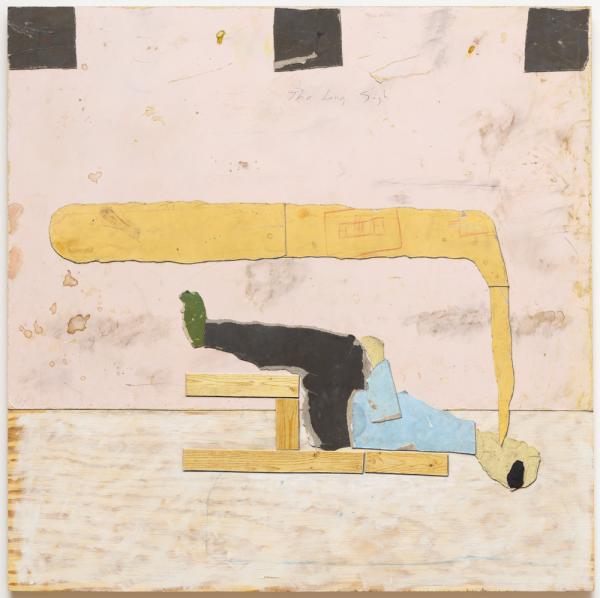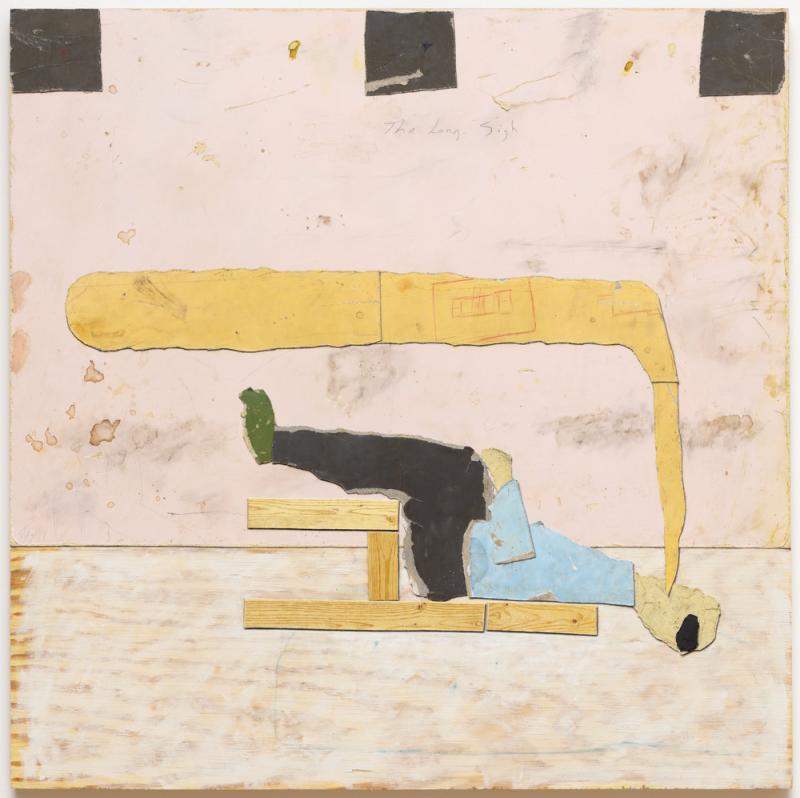Skip to main content
The Long Sigh
Artist
Kirk Hayes
(American, born 1958)
Date2003
MediumOil on signboard
DimensionsUnframed: 40 × 40 in. (101.6 × 101.6 cm)
Credit LineCollection of the Modern Art Museum of Fort Worth, Museum purchase
Object number2003.7
Status
Not on viewCopyright© Kirk Hayes
Category
Label TextA man’s chair has fallen backward, and he finds himself on the floor. A long, cartoonlike speech bubble emanates from his mouth and hovers over his body like an extended exhalation. Above the bubble, in what appears to be the scrawl of a ballpoint pen, the artist Kirk Hayes has labeled the scene “The Long Sigh.” The range of feelings captured in the image—existential anxiety, absurdity, and deadpan humor—is rare not just in contemporary art but in art from any period.
The appearance of The Long Sigh, 2003, matches the guileless quality of its subject. The surface looks to be an assemblage of scraps of colored cardstock, faux wood veneer, and black tape glued onto a messily stained, pin-pricked, and scribbled-on wood panel ground. In fact, Hayes has pulled an elaborate hoax: every material the viewer’s eye perceives is actually painted in oil. Although he begins his process by making a collage of commonplace materials, he then copies that collage on a panel of equal dimensions, mimicking every paper scrap, pencil scrawl, and pinhole in the medium of paint alone. The result is a contemporary instance of trompe l’oeil—a work of art that literally “tricks the eye” with its lifelikeness.
Though largely self-taught as a painter, Hayes reveals a keen knowledge of art history. The collage aesthetic of his paintings and their play with trompe l’oeil hark back to Pablo Picasso and Georges Braque’s innovative juxtapositions of “high” and “low” subjects and materials in their Cubist collages of the 1910s. Hayes’s cartoonlike figures and symbols also evoke the late, figurative style of Philip Guston. Poignant, perplexing, and painstakingly made, Hayes’s art reveals the ongoing capacity of painting to confound, surprise, and move us.
The appearance of The Long Sigh, 2003, matches the guileless quality of its subject. The surface looks to be an assemblage of scraps of colored cardstock, faux wood veneer, and black tape glued onto a messily stained, pin-pricked, and scribbled-on wood panel ground. In fact, Hayes has pulled an elaborate hoax: every material the viewer’s eye perceives is actually painted in oil. Although he begins his process by making a collage of commonplace materials, he then copies that collage on a panel of equal dimensions, mimicking every paper scrap, pencil scrawl, and pinhole in the medium of paint alone. The result is a contemporary instance of trompe l’oeil—a work of art that literally “tricks the eye” with its lifelikeness.
Though largely self-taught as a painter, Hayes reveals a keen knowledge of art history. The collage aesthetic of his paintings and their play with trompe l’oeil hark back to Pablo Picasso and Georges Braque’s innovative juxtapositions of “high” and “low” subjects and materials in their Cubist collages of the 1910s. Hayes’s cartoonlike figures and symbols also evoke the late, figurative style of Philip Guston. Poignant, perplexing, and painstakingly made, Hayes’s art reveals the ongoing capacity of painting to confound, surprise, and move us.











